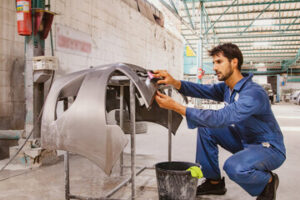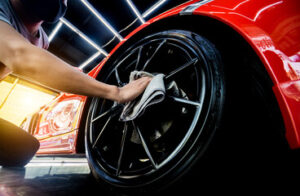Auto fiberglass repair involves more than just a little body filler. It requires careful preparation and the correct use of materials for showroom-quality results.
Our fiberglass repair kit provides do-it-yourselfers with a simple, cost-effective solution for repairs to cracked and broken fiberglass components. This includes fiberglass body panels, windshields, and bumpers. When in doubt, hire a professional Juanito’s Auto Body repair service.

Preparation
The number one factor in the success of any composite repair is proper surface preparation. This is particularly important for fiberglass repairs as the strength of the repair depends upon physical bonding to the original primary structure. During the prep stage, all areas that will be repaired should be cleaned thoroughly and the damaged area should be sanded down to create a smooth surface. The sanded area should then be cleaned with acetone to remove all oils and other contaminants that could interfere with adhesion. The preparation phase should be repeated as needed until the surface of the repair is completely smooth and free of any debris.
The next step is to apply a coat of primer to the area that will receive the fiberglass. The primer should be a high-build polyester primer. This will help to seal the fiberglass and protect it from moisture and other harmful chemicals. It is a good idea to use the same type of primer that was used on the vehicle to ensure a consistent appearance.
After the primer has dried, it is time to begin working on the actual repairs. This will require a fiberglass repair kit that includes the resin, hardener, and fiberglass cloth. Depending on the size of the damage, you may also need body filler and glaze putty. The kit should include instructions that will walk you through the process of preparing and applying the fiberglass patch.
When the fiberglass patch is bonded to the damaged area, it will need to dry for a few days. During this time, it is a good idea to keep the repaired area out of direct sunlight and protected from any heat sources.
Once the fiberglass patch is cured, it can be sanded down to create an even and smooth surface. The sanded surface will then need to be painted with a high-build polyester primer. This coating will help to protect the fiberglass and keep it looking great for a long time.
Fiberglass is a versatile and durable material that can be used for many different purposes. It is commonly used for auto-body repair because it offers a strong, long-lasting, and affordable solution for many common problems. However, fiberglass repair is not without its challenges. Getting your car repaired by a professional will ensure that you get the best results possible. They will be able to handle any type of damage, from minor to severe.
Removal
Fiberglass is a strong, lightweight material that is used in many vehicle components. It is resistant to impact and resists rust, making it ideal for use on the body of cars. However, fiberglass can become damaged by scratches and other forms of wear and tear. If your car’s fiberglass is cracked or damaged, you can take it to a professional repair shop to have it fixed. If you want to repair the damage yourself, you can buy a fiberglass repair kit and follow the instructions.
The first step in the process of repairing a fiberglass panel is to clean it. This is done with acetone or soapy water. The area that is being repaired must be thoroughly cleaned to remove any dirt, grease, or other contaminants that can cause problems with the resin. After the area is clean, it must be sanded to prepare it for the patching process. Once the sanding is complete, the surface should be cleaned again using either acetone or soapy water.
To make the repairs, a technician will measure the amount of resin base and hardener needed for the job. Then, the right kind of fiberglass mat will be applied to the area. There are several different types of mats, including woven mats, chop mats, and loose fibers. A Woven mat is best for flat surfaces and a uniform appearance, while a chopped mat is good for heavy curves. Loose fibers are best for small, irregular areas that are difficult to cover with other types of matting.
This step is crucial to the success of the fiberglass repair. If the resin is not mixed properly, it will never set and will become a sticky mess. If too much catalyst is used, it will be impossible to set and will simply remain a gooey substance. The exact procedure varies by brand, so it is important to follow the instructions carefully.
Although this is a simple repair, it can be tricky for beginners to get it right. If you are not a skilled auto mechanic, it is probably best to take your car to a professional shop to have the work completed.
Patching
Fiberglass is a popular material used to design the body of automobiles. It is durable, lightweight, and can be molded into many different shapes. It also resists impact and won’t rust like steel. However, fiberglass can be damaged by collisions or other accidents. This is why it’s important to have it repaired by a professional. If your car’s fiberglass is damaged, you should take it to an auto body repair shop that specializes in this type of repair. These professionals will ensure that the repair is done correctly.
A professional will start by sanding the area where the repair is going to be made. This will help to create a mechanical bond and remove any dirt or grease. Then, the technician will apply a layer of resin to the surface. Once the resin has been set, the technician will lay a piece of fiberglass cloth or mat over it. The fabric will be saturated with the resin, and any excess will be removed. The technician will then repeat this process until the damage has been repaired.
When repairing fiberglass, it is important to use a quality product and follow the instructions carefully. The repair should also be done in a clean environment. In addition, it is a good idea to use a catalyst in the mixture to help it set faster. This is especially important if the area is going to be exposed to sunlight.
In some cases, the damage to a fiberglass structure may be too severe for patching. In this case, the entire surface of the structure may need to be bonded. A skilled fiberglass technician can repair most types of fiberglass structures, including boats.
When repairing fiberglass, it is best to work in a well-ventilated area with a respirator. Using a respirator will prevent inhaling the fumes from the resin and other chemicals. It is also important to wear protective gloves and eyewear when working with fiberglass. In addition, the worker should have access to a clean water source and a dust suppression system. This will make the job easier and safer for the worker.
Bonding
The final step in the auto fiberglass repair process is to bond the new material to the old. As we mentioned above, this is a key part of ensuring that the finished work is strong and durable. A lot goes into making this bond, from ensuring that the surface is clean and prepped to using the right adhesives and materials. For example, it is essential to use a urethane or epoxy resin to ensure that the bond will be strong and long-lasting. This is particularly important if the repair will be exposed to a lot of moisture.
This can include a vehicle that is driven frequently in damp conditions. This can lead to stress fractures and deterioration of the surface. It is important to address this issue by incorporating a corrosion protection layer in the coatings used during the repair process. Another way to prevent this is to apply a primer and sealant to the repaired area.
Fibreglass is an incredibly useful material for repairs and construction projects that require a high level of durability and strength. It is often used in applications such as boat hulls, flat roofs, water storage tanks, and other structures that can benefit from the resilience of fiberglass.
For automotive applications, several different types of fiberglass can be used in vehicle bodies and components. These include SMC and FRP (traditional fiberglass) as well as a variety of composites such as carbon fiber. While these materials are typically more expensive than other materials, they provide a higher degree of stiffness and strength and are very effective in reducing noise, vibrations, and impact resistance.
Fiberglass is a strong and durable material that is resistant to several different types of damage. However, it is still susceptible to scratches and other common types of wear and tear. If you notice any type of damage to your car’s fiberglass body, it is important to have it fixed by a professional. At some shops, they are fully equipped to repair any fiberglass damage on your vehicle and can restore it to like-new condition.
